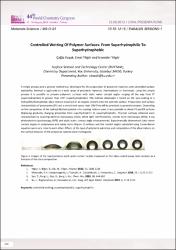From superhydrophilic to superhydrophobic: tunable wetting of polymer surfaces through the use of fumed silica
Özet
A simple process and a general method was developed for the preparation of polymeric materials with controlled surface wettability. Method is applicable to a wide range of polymeric materials, thermoplastic or thermoset. Using this simple process it is possible to prepare polymeric surfaces with static water contact angles ranging all the way from 0° (superhydrophilic) to greater than 170° (superhydrophobic). The method developed is based on the spin-coating of a hydrophilic/hydrophobic silica mixture dispersed in an organic solvent onto the polymer surface. Preparation and surface characteristics of polystyrene (PS) and a crosslinked epoxy resin (ER) films will be provided as general examples. Depending on the composition of the hydrophilic/hydrophobic silica coating mixture used, it was possible to obtain PS and ER surfaces displaying gradually changing properties from superhydrophilic to superhydrophobic. Polymer surfaces obtained were characterized by scanning electron microscopy (SEM), white light interferometry, atomic force microscopy (AFM), X-ray photoelectron spectroscopy (XPS) and static water contact angle measurements. Experimentally determined static water contact angles on polystyrene and epoxy resins (Figure 1) surfaces and the contact angles calculated using Cassie-Baxter equation were very close to each other. Effects of the type of polymeric substrate and composition of the silica mixture on the surface behavior of the composite systems were investigated.

















